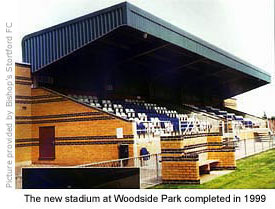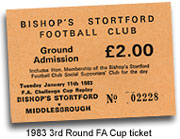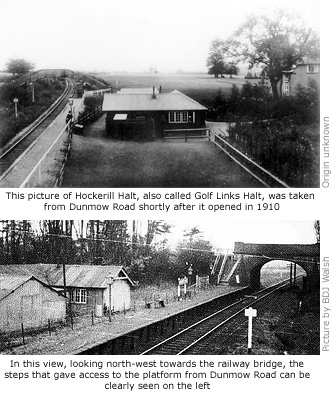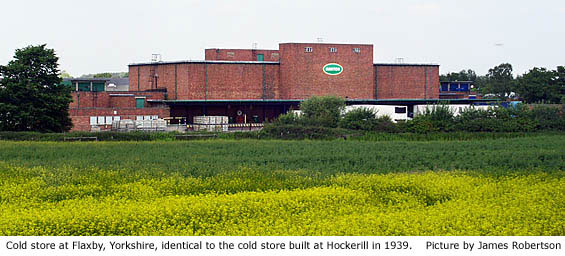|
|
|
 |
|
|
|
|
|
|
|
|
|
Bishop's Stortford Football Club
|
|
 On 17 July 1999, after a long and glorious past at Rhodes Avenue (See Guide 12), Bishop’s Stortford Football Club opened a new chapter in their long history at Woodside Park Stadium.
On 17 July 1999, after a long and glorious past at Rhodes Avenue (See Guide 12), Bishop’s Stortford Football Club opened a new chapter in their long history at Woodside Park Stadium.
Nicknamed the Blues, the club was formed on 28 January 1874 at the Chequers Hotel in North Street, their first match being played two weeks later at Silver Leys against the East of England Non Conformist Grammar School (now Bishop’s Stortford College), which they won 2–1.
From the beginning the club didn’t have a ground of its own and for many years played only ‘friendly’ matches. But this didn’t stop them from becoming one of the founder members of the Hertfordshire Football Association in 1885, and playing in the first County Senior Cup competition that same year.
They progressed into League football in the 1890s and finally moved to a permanent ground at Rhodes Avenue in 1919 (See Guide 12). Unbridled excitement greeted their promotion to the Spartan League in 1929 and their subsequent 5–0 victory over the Ministry of Health team. Many other honours have been won over the years but the pinnacle of success came in their Centenary year; winning the FA Amateur Cup at Wembley by beating Ilford 4–1 in front of 30,000 spectators. It was the last F.A. Amateur Cup Final ever played.
 In the F.A. Cup their best achievement to date was in the 1982/83 season, reaching the 3rd round and forcing a replay at their home ground in Rhodes Avenue with the mighty Middlesbrough. Watched and cheered on by a crowd of 9,000, they were unfortunate to lose the tie 2–1. In the F.A. Cup their best achievement to date was in the 1982/83 season, reaching the 3rd round and forcing a replay at their home ground in Rhodes Avenue with the mighty Middlesbrough. Watched and cheered on by a crowd of 9,000, they were unfortunate to lose the tie 2–1.
Mounting debts in the mid 1990s forced the club to sell its Rhodes Avenue ground for property development, their final match there played just before Christmas 1997. While waiting for construction of Woodside Park to be completed, all ‘home’ matches were played at various other club grounds for the next year and a half.
The very first match at the new stadium was a pre-season friendly against Norwich City – played on 17 July 1999 and resulting in a 2–2 draw. The official opening of the ground was on 3 September 1999 when a match was arranged with Premiership club Tottenham Hotspur. The result was not a particularly good one for the Blues but the match was played in good spirit and attended by almost 2,000 people. www.stortfordfc.co.uk
|
|
|
|
Bishop's Stortford, Dunmow and Braintree Branch Line
|
|
Dunmow Road winds its way back towards the town in a long descent but climbs again, unnaturally, just beyond Raynham Road. This is the result of a man-made embankment constructed in the 1860s to take the road over the Bishop’s Stortford to Braintree branch line. This bridge was the first of only two ‘under’ bridges built in Bishop’s Stortford to accommodate the branch line, the other at Church Manor having already been mentioned.
 In 1939, prior to the outbreak of World War Two, the government built a large Ministry of Food Cold Store Depot close to the north-west side of the bridge, using it for storing large quantities of meat and other foodstuffs regularly conveyed here from the London docks. Serviced by sidings running off the single-line track, the depot continued to be used for this purpose until its closure in 1960, and up until its demolition in 1966 it was used by the London Railway Preservation Society for the storage of a steam locomotive and various rolling stock.
In 1939, prior to the outbreak of World War Two, the government built a large Ministry of Food Cold Store Depot close to the north-west side of the bridge, using it for storing large quantities of meat and other foodstuffs regularly conveyed here from the London docks. Serviced by sidings running off the single-line track, the depot continued to be used for this purpose until its closure in 1960, and up until its demolition in 1966 it was used by the London Railway Preservation Society for the storage of a steam locomotive and various rolling stock.
Fully aware of the branch line and its importance for transporting munitions to the American air base at Stansted, the German Luftwaffe made several attempts to disrupt or destroy it. And one night in October 1940 they very nearly succeeded. Of three bombs dropped in this area, one exploded near the brow of this hill causing a motorist to find himself at the bottom of a 14ft (3.25m) crater; another landed in Church Manor fields; and the third hit nearby Hockerill College with fatal results (See Hockerill College).
Adjacent to the south side of the bridge an entrance once gave public access to Hockerill Halt, a stopping place provided by Great Eastern Railways in 1910 to service Bishop’s Stortford Golf Club. It was hoped the Halt would increase passenger traffic from Braintree and Dunmow, but it never did. It wasn’t exactly a station, more a raised platform built of earth and clinker. Protection against the elements was non existent, but there was a small seat and the Halt gave golfers direct access to the club-house. After suspension of the service during the First World War, Hockerill Halt was later abandoned altogether.
The last passenger train to pass beneath this bridge was in 1952, although the line remained open until 1971 for use by freight trains. By 1974 the entire 18 miles of track that made up the branch line had all been removed (See Guide 11).
|
|
James Robertson, from Yorkshire, is an ex Stortfordian who grew up in a house on the Dunmow Road overlooking the original cold store. Here he gives a brief account of an identical cold store that still operates in Flaxby, Yorkshire, as well as his memory of the Stortford one.
|
|
|
|
 |
|
This photograph is of a cold store identical to the demolished 1939 Ministry of Food store that stood on the northern side of the old Dunmow branch line. It's quite an interesting building architecturally, as it's pretty much symmetrical (very 30s!) and this one at Flaxby, near Knaresborough, is still in use. Surprised one of these cold stores hasn't been listed, because it's classic 30s industrial architecture.
Just in front of the line of bushes behind the field of rape is the York – Harogate branch line. Sidings (now long gone) ran in front of and behind the cold store from the right hand side; you can see the train unloading platform painted black/yellow and the protective awning around the building. The original paint scheme was green for both this and the Bishop's Stortford cold stores, although a half-hearted attempt has been made to paint half this building blue.
If you pass the Dunmow Road entrance to the current cold stores, you'll see a boarded up remnant of the old premises (well, it was there last year (2004) when I passed it!); a single story gatehouse, very much in the same architectural style as the cold store. Where the 1970s cold store is now (adjacent to the Dunmow Road railway bridge), there were several large black corrugated Nissen huts. All the huts and the cold store were connected by sidings, which started at the bridge and ran all the way back to the rear of some houses at Church Manor, opposite Lewis Peasley's former yard in Stortford Hall Park.
|
|
|
|
[ BACK TO TOP ] |
|
|
|
|
|
|
|
|
|




 On 17 July 1999, after a long and glorious past at Rhodes Avenue (See Guide 12), Bishop’s Stortford Football Club opened a new chapter in their long history at Woodside Park Stadium.
On 17 July 1999, after a long and glorious past at Rhodes Avenue (See Guide 12), Bishop’s Stortford Football Club opened a new chapter in their long history at Woodside Park Stadium. In the F.A. Cup their best achievement to date was in the 1982/83 season, reaching the 3rd round and forcing a replay at their home ground in Rhodes Avenue with the mighty Middlesbrough. Watched and cheered on by a crowd of 9,000, they were unfortunate to lose the tie 2–1.
In the F.A. Cup their best achievement to date was in the 1982/83 season, reaching the 3rd round and forcing a replay at their home ground in Rhodes Avenue with the mighty Middlesbrough. Watched and cheered on by a crowd of 9,000, they were unfortunate to lose the tie 2–1. In 1939, prior to the outbreak of World War Two, the government built a large Ministry of Food Cold Store Depot close to the north-west side of the bridge, using it for storing large quantities of meat and other foodstuffs regularly conveyed here from the London docks. Serviced by sidings running off the single-line track, the depot continued to be used for this purpose until its closure in 1960, and up until its demolition in 1966 it was used by the London Railway Preservation Society for the storage of a steam locomotive and various rolling stock.
In 1939, prior to the outbreak of World War Two, the government built a large Ministry of Food Cold Store Depot close to the north-west side of the bridge, using it for storing large quantities of meat and other foodstuffs regularly conveyed here from the London docks. Serviced by sidings running off the single-line track, the depot continued to be used for this purpose until its closure in 1960, and up until its demolition in 1966 it was used by the London Railway Preservation Society for the storage of a steam locomotive and various rolling stock.